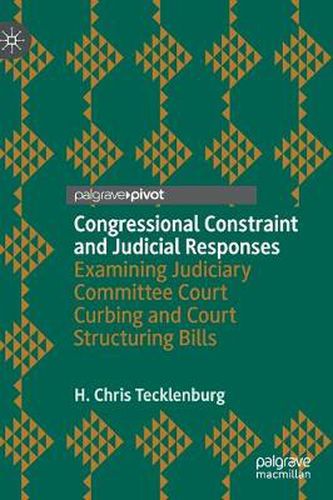Readings Newsletter
Become a Readings Member to make your shopping experience even easier.
Sign in or sign up for free!
You’re not far away from qualifying for FREE standard shipping within Australia
You’ve qualified for FREE standard shipping within Australia
The cart is loading…






This title is printed to order. This book may have been self-published. If so, we cannot guarantee the quality of the content. In the main most books will have gone through the editing process however some may not. We therefore suggest that you be aware of this before ordering this book. If in doubt check either the author or publisher’s details as we are unable to accept any returns unless they are faulty. Please contact us if you have any questions.
This book examines the relationship between Congress and the Federal Judiciary over time. Several aspects of this separation of power dynamics are examined, including court curbing legislation, court structuring legislation, justiciability, and judicial review. Unlike prior works, this book examines this relationship from a bicameral perspective, as it is argued that there are different motivations and reasons as to why and how each chamber of Congress approaches its relationship with the federal judiciary. In addition, this book considers the role of the judiciary committee in the legislative process, as bills that were reported out of committee are examined. Several possible causes of this legislative activity and judicial responses are analyzed, including polarization, judicial review, unanimity on the court, the changing issue agenda of the Court, ideological institutional distance, and divided government. The results reveal that there are important differences with regard to how the chambers interact with the federal judiciary.
$9.00 standard shipping within Australia
FREE standard shipping within Australia for orders over $100.00
Express & International shipping calculated at checkout
This title is printed to order. This book may have been self-published. If so, we cannot guarantee the quality of the content. In the main most books will have gone through the editing process however some may not. We therefore suggest that you be aware of this before ordering this book. If in doubt check either the author or publisher’s details as we are unable to accept any returns unless they are faulty. Please contact us if you have any questions.
This book examines the relationship between Congress and the Federal Judiciary over time. Several aspects of this separation of power dynamics are examined, including court curbing legislation, court structuring legislation, justiciability, and judicial review. Unlike prior works, this book examines this relationship from a bicameral perspective, as it is argued that there are different motivations and reasons as to why and how each chamber of Congress approaches its relationship with the federal judiciary. In addition, this book considers the role of the judiciary committee in the legislative process, as bills that were reported out of committee are examined. Several possible causes of this legislative activity and judicial responses are analyzed, including polarization, judicial review, unanimity on the court, the changing issue agenda of the Court, ideological institutional distance, and divided government. The results reveal that there are important differences with regard to how the chambers interact with the federal judiciary.